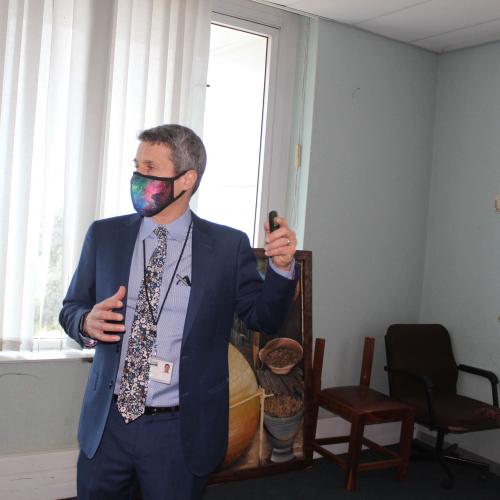By Tapela Morapedi, 31 March 2022
Data from the Tatelo Study conducted by the Botswana Harvard AIDS Institute (BHP) has shown that treatment with broadly neutralizing antibodies (bNAbs) has helped to maintain viral suppression for 24 weeks without ART in 44% of early- treated children with HIV. BHP Board Chair and Principal Investigator of the study, Prof Roger Shapiro said this when sharing data from the study with the Ministry of Health and Wellness (MOHW) on March 16, 2022.
Prof Shapiro’s presentation to MOHW followed his presentation at virtual CROI 2022. Tatelo Study was a single-arm clinical trial performed among children living with HIV in Botswana and it evaluated monthly intravenous infusion of two bNAbs (VRC01LS and 10- 1074) as an alternative to ART in a cohort of very early ART treated children who were virally suppressed.
Study participants were recruited from the Early Infant Treatment (EIT) cohort, who had received continuous ART from the first week of life. Only one child with intra- partum infection started ART at 31 days. To be eligible for inclusion, children had to be at least 96 weeks or older and had HIV RNA < 40 copies for at least 24 weeks prior to entry.
The study had 3 Steps: In the first step, participants received ART + dual bNAbs for 8 weeks. In Step 2, after the ART + bNAb overlap period was completed, ART was withheld and treatment with VRC01LS and 10- 1074 was continued for up to 24 weeks. HIV RNA was checked every 1-2 weeks. Children entered Step 3 if any HIV RNA value reached 400 copies/mL, or at 24 weeks. In Step 3, bNAbs were discontinued and ART was re- started. Intravenous bNAbs infusions were given once every 4 weeks.
Of the 40 children who had been followed in the EIT cohort, 28 were eligible and consented to enroll in Step 1 of the study. The first 6 children underwen 32 weeks of bNAbs + ART overlap, and the remaining 22 underwent 8 weeks of overlap. During this overlap period with ART, 3 children had viral rebounds (all in the 8-week overlap group). bNabs were discontinued in these 3 children, and each re-suppressed with adherence efforts alone while continuing ART. Twenty- five (25) children were moved to Step 2, where ART was withheld and bNAbs were continued alone.
Among the 25 children who stopped ART: 11 (44%) maintained HIV RNA <40 copies/mL through 24 weeks of bNAb-only treatment. These children were categorized as successes, with a 95% confidence interval of 24%-65%. One child in this group had a single HIV RNA value of 234 copies/mL at week 16, then returned to <40 copies for the remaining visits.
Fourteen children (56%) had viral rebound to >400 copies before completing 24 weeks of bNAb-only treatment. The Median time to failure was 4 weeks and ranged from 1 to 20 weeks. These results exceeded the study’s pre-defined threshold for success (which was 30%).
On characteristics of success, Prof Shapiro noted that children with longer ART + bNAb overlap were more likely to succeed: 5 of 6 (83%). Children enrolled earlier in the study as well as those with favorable clinical and reservoir characteristics were also more likely to succeed.
Importantly, for all children, there were no concerning pattern of CD4 decline. “There were no infusion reactions reported and bNAbs were well tolerated. bNAb concentrations were measured as adequate,” said Prof. Shapiro.
He further noted that “newer bNAb combinations with greater breadth and potency used in children with favorable pre-treatment characteristics and possibly with longer bNAb/ART overlap, may improve treatment success for this novel ART-sparing strategy.”
He said that bNAbs could be a favorable option and form of HIV treatment in the future as opposed to ART as long-term ART has adherence challenges and side effects. He said bNAbs suppresses HIV-1 RNA and may deplete residual viral reservoirs hence low viral reservoir and limited HIV diversity may be associated with successful outcomes. He also stated that Children who received early ART might be an ideal group to treat with bNAbs.





